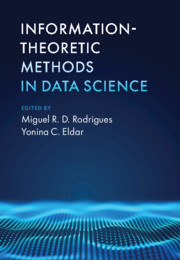Book contents
- Frontmatter
- Dedication
- Contents
- Preface
- Notation
- Contributors
- 1 Introduction to Information Theory and Data Science.
- 2 An Information-Theoretic Approach to Analog-to-Digital Compression
- 3 Compressed Sensing via Compression Codes
- 4 Information-Theoretic Bounds on Sketching
- 5 Sample Complexity Bounds for Dictionary Learning from Vector- and Tensor-Valued Data
- 6 Uncertainty Relations and Sparse Signal Recovery
- 7 Understanding Phase Transitions via Mutual Information and MMSE
- 8 Computing Choice: Learning Distributions over Permutations
- 9 Universal Clustering
- 10 Information-Theoretic Stability and Generalization
- 11 Information Bottleneck and Representation Learning
- 12 Fundamental Limits in Model Selection for Modern Data Analysis
- 13 Statistical Problems with Planted Structures: Information-Theoretical and Computational Limits
- 14 Distributed Statistical Inference with Compressed Data
- 15 Network Functional Compression
- 16 An Introductory Guide to Fano’s Inequality with Applications in Statistical Estimation
- Index
- References
3 - Compressed Sensing via Compression Codes
Published online by Cambridge University Press: 22 March 2021
- Frontmatter
- Dedication
- Contents
- Preface
- Notation
- Contributors
- 1 Introduction to Information Theory and Data Science.
- 2 An Information-Theoretic Approach to Analog-to-Digital Compression
- 3 Compressed Sensing via Compression Codes
- 4 Information-Theoretic Bounds on Sketching
- 5 Sample Complexity Bounds for Dictionary Learning from Vector- and Tensor-Valued Data
- 6 Uncertainty Relations and Sparse Signal Recovery
- 7 Understanding Phase Transitions via Mutual Information and MMSE
- 8 Computing Choice: Learning Distributions over Permutations
- 9 Universal Clustering
- 10 Information-Theoretic Stability and Generalization
- 11 Information Bottleneck and Representation Learning
- 12 Fundamental Limits in Model Selection for Modern Data Analysis
- 13 Statistical Problems with Planted Structures: Information-Theoretical and Computational Limits
- 14 Distributed Statistical Inference with Compressed Data
- 15 Network Functional Compression
- 16 An Introductory Guide to Fano’s Inequality with Applications in Statistical Estimation
- Index
- References
Summary
In compressed sensing (CS) a signal x ∈ Rn is measured as y =A x + z, where A ∈ Rm×n (m<n) and z ∈ Rm denote the sensing matrix and measurement noise. The goal is to recover x from measurements y when m<n. CS is possible because we typically want to capture highly structured signals, and recovery algorithms take advantage of a signal’s structure to solve the under-determined system of linear equations. As in CS, data-compression codes take advantage of a signal’s structure to encode it efficiently. Structures used by compression codes are much more elaborate than those used by CS algorithms. Using more complex structures in CS, like those employed by data-compression codes, potentially leads to more efficient recovery methods requiring fewer linear measurements or giving better reconstruction quality. We establish connections between data compression and CS, giving CS recovery methods based on compression codes, which indirectly take advantage of all structures used by compression codes. This elevates the class of structures used by CS algorithms to those used by compression codes, leading to more efficient CS recovery methods.
Information
- Type
- Chapter
- Information
- Information-Theoretic Methods in Data Science , pp. 72 - 103Publisher: Cambridge University PressPrint publication year: 2021
